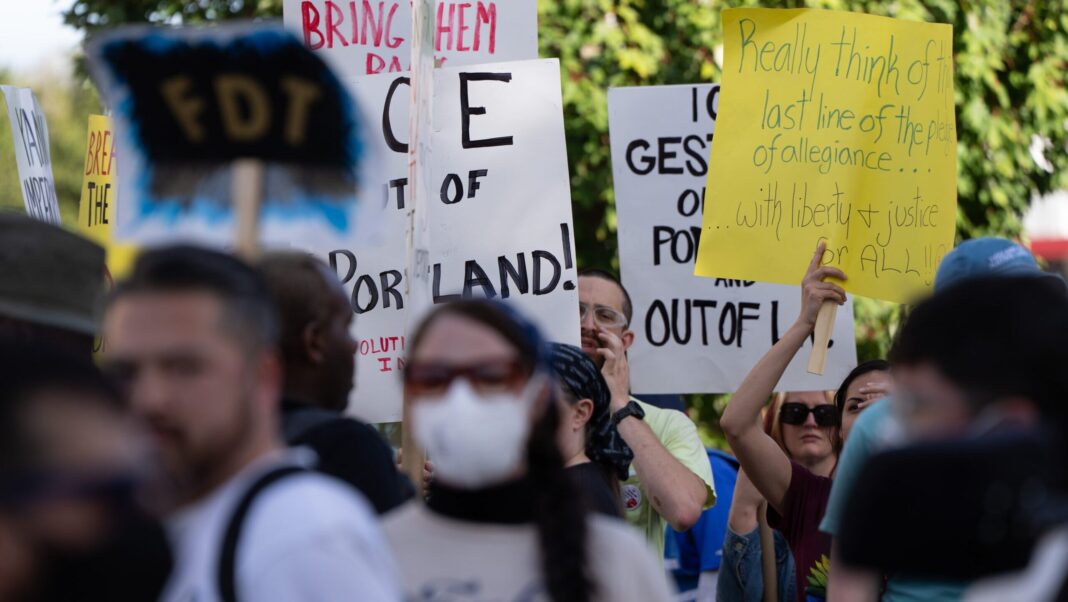Federal Agents and Troops: A New Presence in U.S. Cities
In recent weeks, armed federal agents have taken to the streets of major U.S. cities, raising questions about the militarization of law enforcement and the implications for local communities. Chicago’s downtown saw a significant presence of federal agents, while President Donald Trump ordered the deployment of National Guard troops to Portland, Oregon—a move that faced immediate backlash from local officials.
Armed Federal Agents in Chicago
On Sunday, Chicago became a stage for federal authorities, with dozens of armed agents patrolling iconic areas like Michigan Avenue. Clad in tactical gear, these agents were part of what federal officials called a mission to target “the worst of the worst”—individuals living in the U.S. illegally who have criminal records. However, this forceful display caused unease among residents and tourists alike.
Local leaders, including Chicago Mayor Brandon Johnson and Illinois Governor JB Pritzker, criticized the federal presence. Johnson described the situation as intimidation, stating that armed agents were instilling fear rather than ensuring safety. Pritzker echoed these sentiments, emphasizing that the agents’ intimidating posture was detrimental to both community morale and local businesses.
Tensions at ICE Protests
The federal presence in Chicago coincided with rising tensions around immigration enforcement, particularly at an ICE facility in Broadview, a suburb of Chicago. Protests erupted as demonstrators sought to block agents from executing arrests. Escalating conflicts led federal authorities to deploy pepper balls and tear gas, drawing severe criticism from local officials. Broadview’s mayor condemned ICE for its aggressive tactics, claiming it endangered local police and residents.
Activists have argued that the facility is operating as a de facto detention center with troubling conditions. The backdrop of these protests highlights a broader anxiety about the government’s approach to immigration enforcement, further fueled by Trump’s rhetoric surrounding crime and safety.
Trump’s Decision in Portland
On the West Coast, Trump’s directive to deploy 200 National Guard troops to Portland was designed to tackle what he termed “violent protests.” His assertions of a national emergency around the protection of federal property were met with resistance from Oregon Governor Tina Kotek, who deemed the troop deployment unnecessary and abusive of power. She asserted that local officials could manage public safety without federal assistance.
Following this declaration, Oregon Attorney General Dan Rayfield swiftly filed a lawsuit arguing Trump overstepped his authority by not allowing local governance to address the situation. He highlighted that the circumstances in Portland didn’t constitute a crisis necessitating military intervention, framing the deployment as an overreach.
Memphis: A Task Force Against Crime
Simultaneously, in Memphis, Tennessee, Trump announced a newly created task force aimed at combatting rising crime rates. Despite media panic focusing on violent crime, local leaders have noted a decline in many crime categories, creating a complex backdrop for the federal involvement.
Tennessee Governor Bill Lee described expectations for around 150 National Guard members to assist local police, insisting that this presence would not involve armed troops making arrests. Concerns linger among Memphis residents, especially within the Latino community, regarding potential ICE operations and the possibility of increased scrutiny on immigrants, regardless of their legal status.
Community Reactions and Conversations
Across these cities, community responses have spotlighted a consistent theme: the call for investment in local infrastructure rather than a show of military force. Protesters in both Memphis and Chicago have articulated a collective longing for increased funding for education, healthcare, and social services as opposed to a militarized approach to public safety.
Local officials and activists have unequivocally stated that the presence of federal law enforcement agents does not equate to enhanced security and that community well-being cannot be nurtured through intimidation tactics. Instead, residents hope for a more compassionate and comprehensive approach to law enforcement—one that prioritizes trust and the well-being of all citizens.
As these developments continue to unfold, they raise critical questions about federal versus local authority, community safety, and the role of law enforcement in a rapidly changing social landscape. The conversations sparked by these events are vital as communities assess the path forward amidst increasing tensions.



